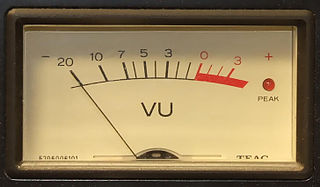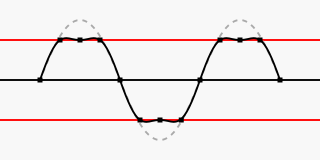The decibel is a relative unit of measurement equal to one tenth of a bel (B). It expresses the ratio of two values of a power or root-power quantity on a logarithmic scale. Two signals whose levels differ by one decibel have a power ratio of 101/10 or root-power ratio of 101⁄20.

Dynamic range compression (DRC) or simply compression is an audio signal processing operation that reduces the volume of loud sounds or amplifies quiet sounds, thus reducing or compressing an audio signal's dynamic range. Compression is commonly used in sound recording and reproduction, broadcasting, live sound reinforcement and some instrument amplifiers.

Audio system measurements are a means of quantifying system performance. These measurements are made for several purposes. Designers take measurements so that they can specify the performance of a piece of equipment. Maintenance engineers make them to ensure equipment is still working to specification, or to ensure that the cumulative defects of an audio path are within limits considered acceptable. Audio system measurements often accommodate psychoacoustic principles to measure the system in a way that relates to human hearing.

In acoustics, loudness is the subjective perception of sound pressure. More formally, it is defined as the "attribute of auditory sensation in terms of which sounds can be ordered on a scale extending from quiet to loud". The relation of physical attributes of sound to perceived loudness consists of physical, physiological and psychological components. The study of apparent loudness is included in the topic of psychoacoustics and employs methods of psychophysics.
Near Instantaneous Companded Audio Multiplex (NICAM) is an early form of lossy compression for digital audio. It was originally developed in the early 1970s for point-to-point links within broadcasting networks. In the 1980s, broadcasters began to use NICAM compression for transmissions of stereo TV sound to the public.

A volume unit (VU) meter or standard volume indicator (SVI) is a device displaying a representation of the signal level in audio equipment.
Audio normalization is the application of a constant amount of gain to an audio recording to bring the amplitude to a target level. Because the same amount of gain is applied across the entire recording, the signal-to-noise ratio and relative dynamics are unchanged. Normalization is one of the functions commonly provided by a digital audio workstation.
In digital and analog audio, headroom refers to the amount by which the signal-handling capabilities of an audio system can exceed a designated nominal level. Headroom can be thought of as a safety zone allowing transient audio peaks to exceed the nominal level without damaging the system or the audio signal, e.g., via clipping. Standards bodies differ in their recommendations for nominal level and headroom.

Decibels relative to full scale is a unit of measurement for amplitude levels in digital systems, such as pulse-code modulation (PCM), which have a defined maximum peak level. The unit is similar to the units dBov and decibels relative to overload (dBO).

A peak programme meter (PPM) is an instrument used in professional audio that indicates the level of an audio signal.

The loudness war is a trend of increasing audio levels in recorded music, which reduces audio fidelity and—according to many critics—listener enjoyment. Increasing loudness was first reported as early as the 1940s, with respect to mastering practices for 7-inch singles. The maximum peak level of analog recordings such as these is limited by varying specifications of electronic equipment along the chain from source to listener, including vinyl and Compact Cassette players. The issue garnered renewed attention starting in the 1990s with the introduction of digital signal processing capable of producing further loudness increases.
dBm0 is an abbreviation for the power in dBm measured at a zero transmission level point (ZLP).
Programme level refers to the signal level that an audio source is transmitted or recorded at, and is important in audio if listeners of Compact Discs (CDs), radio and television are to get the best experience, without excessive noise in quiet periods or distortion of loud sounds. Programme level is often measured using a peak programme meter or a VU meter.
Audio noise measurement is a process carried out to assess the quality of audio equipment, such as the kind used in recording studios, broadcast engineering, and in-home high fidelity.
Loudness monitoring of programme levels is needed in radio and television broadcasting, as well as in audio post production. Traditional methods of measuring signal levels, such as the peak programme meter and VU meter, do not give the subjectively valid measure of loudness that many would argue is needed to optimise the listening experience when changing channels or swapping disks.
Nominal level is the operating level at which an electronic signal processing device is designed to operate. The electronic circuits that make up such equipment are limited in the maximum signal they can handle and the low-level internally generated electronic noise they add to the signal. The difference between the internal noise and the maximum level is the device's dynamic range. The nominal level is the level that these devices were designed to operate at, for best dynamic range and adequate headroom. When a signal is chained with improper gain staging through many devices, clipping may occur or the system may operate with reduced dynamic range.
Broadcast-safe video is a term used in the broadcast industry to define video and audio compliant with the technical or regulatory broadcast requirements of the target area or region the feed might be broadcasting to. In the United States, the Federal Communications Commission (FCC) is the regulatory authority; in most of Europe, standards are set by the European Broadcasting Union (EBU).
EBU R 128 is a recommendation for loudness normalisation and maximum level of audio signals. It is primarily followed during audio mixing of television and radio programmes and adopted by broadcasters to measure and control programme loudness. It was first issued by the European Broadcasting Union in August 2010 and most recently revised in August 2020.

An audio analyzer is a test and measurement instrument used to objectively quantify the audio performance of electronic and electro-acoustical devices. Audio quality metrics cover a wide variety of parameters, including level, gain, noise, harmonic and intermodulation distortion, frequency response, relative phase of signals, interchannel crosstalk, and more. In addition, many manufacturers have requirements for behavior and connectivity of audio devices that require specific tests and confirmations.
Loudness, K-weighted, relative to full scale (LKFS) is a standard loudness measurement unit used for audio normalization in broadcast television systems and other video and music streaming services.







